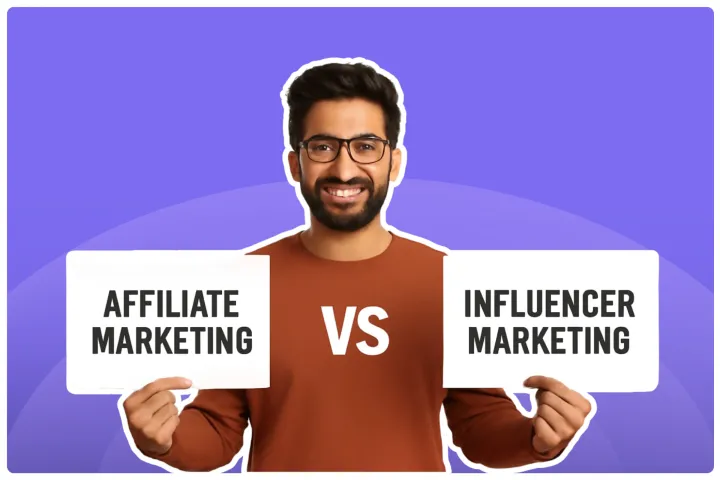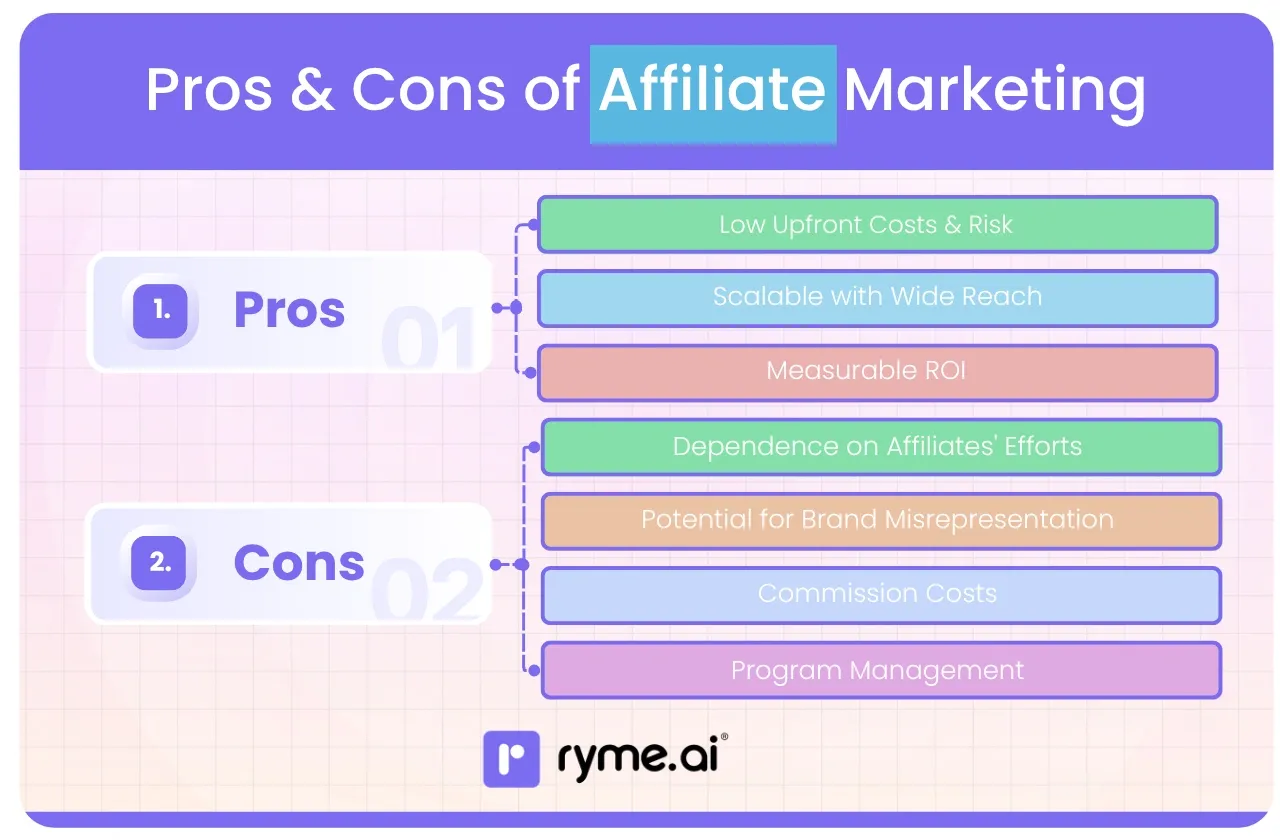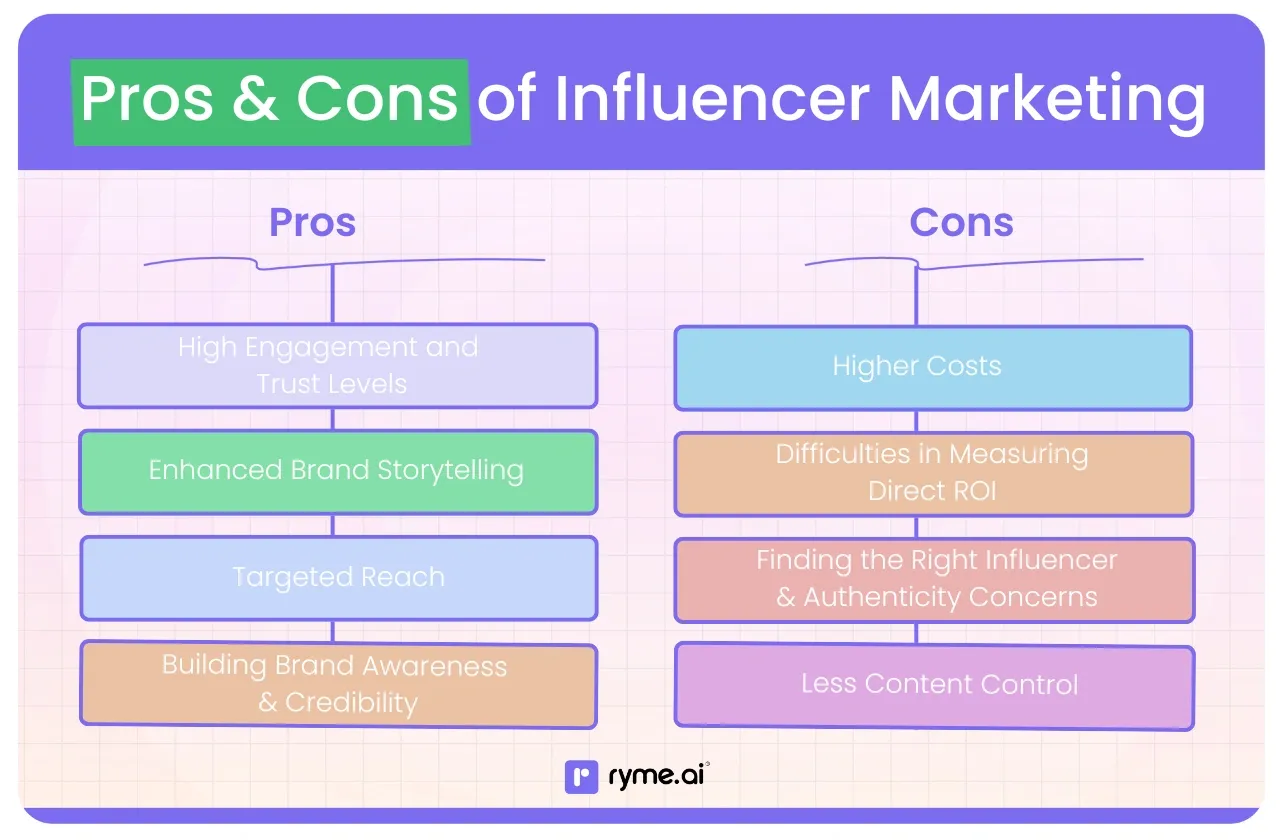Affiliate Marketing Vs Influencer Marketing: What, Why & How (2025)
Discover the key differences between affiliate marketing and influencer marketing. Learn what they are, why they matter, and how to leverage them for success!

Growing your brand means getting your amazing products or services in front of the right people. But how do you do that effectively without blowing your budget? Two powerful strategies often come up: Affiliate Marketing and Influencer Marketing.
They might sound similar sometimes, but they work differently and achieve distinct goals for your business. Think of this guide as your friendly map to understanding both, figuring out which one (or maybe both!) fits your brand best, and how you can even use cool tools like ryme.ai to make your life easier, especially with influencer collaborations.
We get it – marketing can feel overwhelming. There are so many options! But understanding these two popular methods is a great starting point. We'll break it down simply, talk about the good and the not-so-good bits, and give you real, practical insights. Ready to figure out how to connect with more customers and grow your business? Let's go!
What Is Affiliate Marketing?
At its core, affiliate marketing is a strategy where your business partners with individuals or companies (affiliates). These affiliates promote your products or services. You provide them with a unique trackable link. When someone clicks that link and makes a purchase or completes a desired action (like signing up for a newsletter – known as a lead), the affiliate earns a commission. It’s purely performance-based. No sale, no commission. Simple.
This model has become incredibly popular, especially for e-commerce businesses. Recent data highlights its continuous growth. For instance, studies from 2023 indicated that global spending on affiliate marketing continues to rise year over year, demonstrating its effectiveness and sustained relevance for businesses aiming for measurable results.
Key Components:
Let's meet the players in this game:
1) Merchants (That's You!): You are the business, the brand, the seller. You have a product or service you want to sell. You decide the commission rates, provide the tracking links, and ultimately pay the affiliates for the sales or leads they generate. Your goal is to increase sales and reach new customers cost-effectively.
2) Affiliates: These are your partners in promotion. They can be individuals like bloggers, social media enthusiasts, or even established websites and companies. They sign up for your affiliate program, choose which products to promote, and use their platforms (websites, blogs, social media channels, email lists) to drive traffic to your site through their unique affiliate links.
Their motivation? Earning commissions. A successful affiliate understands their audience and recommends products genuinely.
3) Consumers (The Customers): These are the end-users who see the affiliate's promotional content, click the unique link, and land on your website. If they make a purchase or complete the target action, they get the product they want, and the affiliate gets rewarded. Importantly, the price for the consumer is typically the same whether they use an affiliate link or not. The commission comes out of your marketing budget, not by inflating the price.
4) Affiliate Network (Optional but Common): Often, there's an intermediary platform called an affiliate network (like Commission Junction, ShareASale, or Rakuten Advertising). These networks act as a marketplace, connecting merchants with affiliates.
They handle the tracking, reporting, and payment processing, making management easier for both parties. You can also run an in-house program, but networks offer broader reach and infrastructure.
Mechanism:
How does it actually work?
It's all about the tracking link.
- An affiliate joins your program (either directly or via a network).
- You provide them with unique URLs for the products/services they want to promote. These links contain special tracking codes specific to that affiliate.
- The affiliate places these links within their content – maybe a blog review, a social media post, a banner ad on their site, or an email newsletter.
- A consumer clicks on the affiliate's unique link.
- A cookie is placed on the consumer's browser. This cookie identifies the affiliate who referred them and typically has a set duration (e.g., 30 days). This means if the consumer doesn't buy immediately but comes back within that window to purchase, the affiliate still gets credit.
- The consumer makes a purchase on your website.
- The tracking system (yours or the network's) records the purchase and attributes it to the referring affiliate based on the cookie.
- You approve the sale (ensuring it wasn't fraudulent or returned).
- The affiliate receives their commission based on the agreed terms (e.g., a percentage of the sale amount or a fixed amount per lead).
This mechanism ensures that affiliates are rewarded accurately for the value they bring, making it a transparent process.
Pros (Why Brands Love It):
Let's look at the bright side for your business:
1) Low Upfront Costs & Risk: This is a big one. Unlike traditional advertising where you pay upfront regardless of results, affiliate marketing is primarily pay-for-performance. You only pay commissions after a sale or lead is generated.
This significantly lowers the financial risk, especially for businesses with tight budgets. You're essentially paying for results, not just exposure. A 2023 survey of marketers often cited this performance-based model as a primary reason for investing in affiliate marketing.
2) Scalable with Wide Reach: Your potential reach isn't limited by your own marketing team's capacity. By partnering with numerous affiliates, you can tap into diverse audiences and niche markets that you might not reach otherwise.
Good affiliates have already built trust with their audience. Leveraging that trust can significantly expand your customer base. You can scale your program up or down based on your needs and budget.
3) Measurable ROI: Because every click and sale generated through an affiliate link is tracked, measuring your Return on Investment (ROI) is relatively straightforward. You can see exactly which affiliates are driving the most valuable traffic and sales, allowing you to optimize your program and focus your resources effectively. Analytics platforms provide detailed reports on clicks, conversion rates, and revenue generated per affiliate.
Cons (Things to Watch Out For):
It's not all smooth sailing. Here are potential challenges:
1) Dependence on Affiliates' Efforts: Your success relies heavily on the motivation and effectiveness of your affiliates. If they aren't actively promoting your products or if their promotional methods aren't resonating with their audience, you won't see results. You need to actively recruit, manage, and motivate your affiliates.
2) Potential for Brand Misrepresentation: This is crucial. If you don't monitor your affiliates closely, some might resort to misleading advertising, spammy tactics, or making inaccurate claims about your product to drive sales. This can damage your brand's reputation. Clear guidelines, terms of service, and regular monitoring are essential to maintain brand integrity. You need to ensure affiliates represent your brand values accurately.
3) Commission Costs: While you only pay for performance, high commission rates (especially in competitive niches) can eat into your profit margins. You need to find a balance that incentivizes affiliates but remains profitable for your business.
4) Program Management: Running an affiliate program requires effort. You need to recruit affiliates, provide them with marketing materials (banners, links, product info), track performance, handle payments, and communicate regularly. Using an affiliate network can simplify some aspects but still requires oversight.

Affiliate marketing is a powerful tool for driving sales and expanding reach, especially when you focus on building strong relationships with quality affiliates who genuinely align with your brand.
What Is Influencer Marketing?
Influencer marketing involves collaborating with individuals who have a dedicated and engaged following on social media platforms (like Instagram, YouTube etc.). These individuals, known as influencers, have built credibility and authority within a specific niche (e.g., beauty, fitness, tech, food, travel).
Brands partner with them to promote products or services through authentic, engaging content created by the influencer. The goal is often broader than just immediate sales; it includes building brand awareness, enhancing brand image, and fostering deeper customer connections.
The influencer marketing industry has exploded. Reports from 2023-2024 consistently show significant growth in spending, with platforms like Instagram being dominant channels, especially for reaching younger demographics like Gen Z. In India alone, the market value was estimated to be well over ₹1,800 crore in 2023 and projected to grow upto ₹3,375 crore by 2026.
Types of Influencers:
Influencers aren't one-size-fits-all. They are often categorized by their follower count, which usually correlates with their reach and cost:
Nano-influencers (1,000 – 10,000 followers): These are everyday people with smaller, often highly niche and engaged followings. They typically have strong personal connections with their audience, leading to high trust levels. They are often more affordable and great for targeting specific local or niche communities. Think of a local food blogger reviewing your neighbourhood cafe.
Micro-influencers (10,000 – 100,000 followers): Similar to nano-influencers but with a larger reach. They still maintain strong engagement rates and are often seen as experts in their specific field (e.g., sustainable fashion, vegan cooking, indie gaming).
They offer a good balance between reach and authenticity. Many brands find the "sweet spot" here. A 2023 HubSpot report highlighted that micro-influencers often yield higher engagement rates compared to larger influencers.
Macro-influencers (100,000 – 1 million followers): These are often established content creators, bloggers, or public figures who have built a significant audience. They offer broader reach and are suitable for awareness campaigns targeting a larger demographic. Think of a well-known tech YouTuber reviewing the latest smartphone.
Their rates are higher, and their engagement rates might be slightly lower percentage-wise than micros, but the absolute number of people reached is substantial.
Mega-influencers (Over 1 million followers): These are typically celebrities, top-tier bloggers, or social media superstars. They command the highest fees and offer massive reach, often crossing into mainstream awareness. Collaborations with mega-influencers are usually reserved for large brands with significant marketing budgets aiming for maximum visibility. Think of a Bollywood star endorsing a major fashion label.
Choosing the right type of influencer depends entirely on your campaign goals, target audience, and budget. Don't just chase follower counts; engagement and audience alignment are far more important.
Mechanism:
How does an influencer collaboration typically unfold?
1) Discovery & Vetting: You identify potential influencers whose audience matches your target demographic and whose content style aligns with your brand values. Tools like ryme.ai can help here, or you can search manually on platforms. You vet them for authenticity (e.g., checking for fake followers, analysing engagement quality).
2) Outreach & Negotiation: You contact the influencer (or their agent) with a collaboration proposal. This includes outlining the campaign goals, content requirements, deliverables (e.g., 1 Instagram Reel, 2 Stories, 1 static post), timeline, and compensation (flat fee, free product, commission, or a hybrid model).
3) Briefing & Content Creation: Once terms are agreed upon, you provide a creative brief. This should give clear direction but also allow the influencer creative freedom to produce content that feels authentic to their audience. Too much control can make the content seem like a forced ad. The influencer creates the content (photos, videos, blog posts).
4) Approval & Posting: You review the content (if pre-approval is part of the agreement) to ensure it meets guidelines and accurately represents the product. The influencer then posts the content on their agreed channels, ensuring proper disclosure (e.g., using #ad, #sponsored, or platform-specific tools like Instagram's "Paid Partnership" tag – this is legally required in many regions, including India).
5) Promotion & Engagement: The influencer might engage with comments and questions from their audience about the product, adding further credibility.
6) Reporting & Analysis: You track the performance of the campaign using metrics like reach (how many people saw the content), impressions (how many times it was displayed), engagement (likes, comments, shares, saves), website traffic (using UTM parameters in links if provided), and sometimes, conversions (though direct attribution can be tricky).
The key here is collaboration. It's a partnership where the influencer lends their voice and credibility to your brand.
Pros (Why It's Powerful for Brands):
Influencer marketing offers unique advantages:
1) High Engagement and Trust Levels: Influencers have cultivated relationships with their followers. Recommendations from them often feel more like advice from a trusted friend than traditional advertising.
This leads to higher engagement rates (likes, comments, shares) and can significantly impact purchasing decisions. A Nielsen study from previous years consistently showed consumers trust recommendations from people they know (even online "friends") over brand advertising.
2) Enhanced Brand Storytelling: Influencers are skilled content creators. They can weave your product or service into authentic narratives and lifestyle content, showcasing it in a relatable context. This helps humanize your brand and tell its story in a more compelling way than a standard ad ever could. Think of a travel influencer showing how your luggage performs on a real trip.
3) Targeted Reach: Influencers often cater to very specific niches and demographics. By partnering with the right influencer, you can reach your ideal target audience directly and effectively, ensuring your message resonates with people genuinely interested in your category.
4) Building Brand Awareness & Credibility: Collaborating with respected influencers can boost your brand's visibility and lend it credibility by association. When an influencer aligns with your brand, their positive reputation can rub off on you.
Cons (Potential Hurdles):
Consider these challenges before diving in:
1) Higher Costs: Influencer marketing can be expensive, especially when working with macro or mega influencers. Costs can range from a few thousand rupees (₹) for nano-influencers to lakhs or even crores for top-tier celebrities. Pricing depends on follower count, engagement rate, niche, content requirements, and usage rights.
Unlike affiliate marketing's pay-for-performance model, many influencers require upfront flat fees regardless of sales generated. Recent industry reports (2023-2024) indicate rising influencer rates as demand grows.
2) Difficulties in Measuring Direct ROI: While you can track engagement metrics, directly attributing sales to a specific influencer post can be challenging unless you incorporate trackable links or unique discount codes. The impact is often more focused on upper-funnel metrics like awareness and consideration, rather than immediate conversions. This makes proving direct ROI harder compared to affiliate marketing.
3) Finding the Right Influencer & Authenticity Concerns: Identifying influencers who genuinely align with your brand values and have an authentic, engaged following takes time and effort. There's also the risk of partnering with influencers who have purchased followers or whose endorsements seem inauthentic, which can backfire and harm your brand. Due diligence is critical.
4) Less Content Control: To maintain authenticity, influencers need creative freedom. This means you have less direct control over the final messaging compared to creating your own ads or providing strict guidelines to affiliates. You need to trust the influencer to represent your brand appropriately while staying true to their own style.

Influencer marketing excels at building brand love, telling stories, and reaching specific audiences through trusted voices. It's less about the hard sell and more about building connections.
Affiliate Marketing vs Influencer Marketing – A Comparative Analysis
Alright, we've defined both strategies. Now, let's put them side-by-side to really understand their core differences and when you might choose one over the other (or both!). Think of it like choosing between different tools in your marketing toolkit – each is designed for a specific job.
Let's break these down further:
Objective:
Affiliate Marketing: The goal here is crystal clear: generate sales or leads. It's a bottom-of-the-funnel strategy focused on driving conversions. Success is measured primarily by the revenue generated through affiliate links. You use affiliates to directly push customers towards making a purchase.
Influencer Marketing: While sales can be a byproduct (and increasingly tracked), the primary objective is often broader. It's about introducing your brand to new audiences, building positive sentiment, increasing engagement, and positioning your brand within a certain lifestyle or community. It operates more towards the top and middle of the marketing funnel – awareness and consideration.
Compensation Models:
Affiliate Marketing: Almost exclusively performance-based. You pay a percentage of the sale (Pay-Per-Sale, PPS) or a fixed amount for a specific action like a sign-up (Pay-Per-Lead, PPL). This aligns the affiliate's incentive directly with your sales goals.
Influencer Marketing: Compensation is more varied. Flat fees for creating and posting content are very common, especially with larger influencers. Product gifting (where the influencer receives the product for free in exchange for potential coverage) is frequent with smaller influencers. Hybrid models (e.g., a smaller flat fee plus a commission on sales driven through a unique code or link) are also emerging. The fee often reflects the influencer's reach, engagement, effort, and usage rights for the content.
Content Control:
Affiliate Marketing: You generally have more say. You provide the specific links, often dictate the offer or discount associated with the link, and might provide approved banner ads or product descriptions. While affiliates create the surrounding content (like a review), the core promotional message and offer are usually tightly defined by you.
Influencer Marketing: Authenticity is paramount here. To maintain trust with their audience, influencers need creative control. You provide a brief outlining goals and key messages, but the influencer crafts the content in their own style and voice. Micromanaging can lead to content that feels like a forced ad, defeating the purpose. It’s a balance between guidance and freedom.
Tracking and Metrics:
Affiliate Marketing: Tracking is precise and direct. Unique links and cookies allow you to attribute sales accurately to specific affiliates. Key metrics are clicks, conversion rates, Average Order Value (AOV), revenue generated, and ultimately, ROI. Analytics are usually quite robust, provided by your in-house system or an affiliate network.
Influencer Marketing: Tracking direct sales can be trickier. While you can use UTM parameters in links or unique discount codes, much of the value lies in less tangible metrics. You'll focus on reach (how many people saw the post), impressions (how many times it was viewed), engagement rate (likes, comments, shares, saves relative to followers), follower growth, website traffic referrals, and qualitative feedback like brand sentiment in comments.
Measuring direct ROI in terms of immediate sales is often more challenging. Platforms and tools are improving analytics here, but it's different from the clear attribution of affiliate marketing. Recent surveys (2023-2024) show that measuring ROI remains a top challenge for brands engaging in influencer marketing.
Best Use Cases:
While there's overlap, certain business types or goals lend themselves better to one strategy initially:
Affiliate Marketing: Particularly strong for:
- E-commerce businesses with clear conversion funnels.
- Companies selling digital products (software, courses, ebooks).
- Brands focused on driving high volumes of sales with measurable ROI.
- Subscription services seeking new sign-ups.
- Businesses with tighter marketing budgets prioritizing performance-based spending.
Influencer Marketing: Especially effective for:
- Lifestyle brands (fashion, beauty, fitness, home decor).
- Travel and hospitality industries.
- Food and beverage companies.
- Brands launching new products needing buzz and awareness.
- Businesses aiming to build community and long-term brand loyalty.
- Companies targeting specific demographics (like Gen Z on TikTok or Instagram).
Understanding these differences helps you allocate your marketing budget and efforts more effectively based on what you want to achieve. Are you looking for immediate, trackable sales? Affiliate marketing might be your primary focus. Are you trying to build brand love, tell a story, and connect with a specific audience? Influencer marketing could be the better starting point.
Integrating Affiliate and Influencer Marketing Strategies
Okay, so we've seen they're different. But here’s where it gets really interesting: Affiliate and Influencer marketing don't have to live in separate boxes! In fact, combining them can create a powerful synergy, leveraging the strengths of both approaches. Think of it as getting the best of both worlds – the storytelling and trust of influencers, combined with the trackable performance of affiliate marketing. 😉
Synergistic Approach:
Imagine this: You partner with an influencer who genuinely loves your product. They create authentic, engaging content (like an Instagram Reel or a YouTube video) showcasing how they use it in their daily life. This builds awareness and trust. Now, instead of just ending the post there, they include a unique affiliate link or a special discount code in their caption or bio.
What happens?
- Awareness & Trust (Influencer): The influencer's content introduces your brand to their engaged audience in a relatable way.
- Direct Action & Tracking (Affiliate): The affiliate link gives interested followers a clear path to purchase and allows you to track exactly how many sales that specific influencer generated.
- Incentive Alignment: The influencer is motivated not just by an upfront fee (if any) but also by earning commissions on the sales they drive, encouraging them to create content that genuinely converts.
This integrated approach allows influencers to monetize their influence beyond flat fees while giving brands a way to measure the direct sales impact of their influencer collaborations more effectively. It bridges the gap between upper-funnel awareness and bottom-funnel conversions.
Implementation Tips:
Ready to give this hybrid model a try? Here’s how you can implement it effectively:
- Provide Influencers with Unique Affiliate Links: Don't just give them a standard link to your site. Set them up as affiliates in your existing affiliate program (or create a simple one). Provide each influencer with their own unique, trackable affiliate link. This is crucial for attribution.
- Offer Unique Discount Codes: Another popular method is providing each influencer with a unique discount code (e.g., "RIYA15" for 15% off). This is easy for followers to remember and use, and you can track sales associated with each code. You can use this alongside or instead of an affiliate link.
- Consider a Hybrid Compensation Model: You might offer a lower flat fee combined with a commission structure. This respects the influencer's time for content creation while also incentivizing sales performance. For smaller influencers, a commission-only model might even work if your product and commission rate are attractive.
- Be Crystal Clear on Terms & Disclosure: Ensure your agreement clearly outlines both the content requirements and the affiliate commission structure (rate, cookie duration, payment terms). Crucially, remind influencers they need to disclose both the paid partnership and the affiliate nature of the link/code, according to advertising standards (like ASCI guidelines in India). Transparency is key to maintaining audience trust.
- Track Both Sets of Metrics: Don't just focus on sales. Monitor the influencer's traditional engagement metrics (reach, likes, comments, shares) and the affiliate performance metrics (clicks, conversion rate, revenue) coming from their specific link or code. This gives you a holistic view of their impact – both brand building and sales driving.
- Use UTM Parameters: Even if using affiliate links, adding UTM parameters can provide deeper insights into traffic behaviour within your own analytics (like Google Analytics). You can tag the source (influencer name), medium (social), and campaign name.
- Build Long-Term Ambassador Programs: Instead of one-off campaigns, consider creating longer-term ambassador programs. Select influencers who genuinely align with your brand, provide them with ongoing affiliate links/codes, potentially a retainer fee, and empower them to consistently promote your products over time. This fosters deeper loyalty and more authentic advocacy.
- Adjust Strategies Based on Data: Use the combined data to see which influencers are driving not just engagement but actual results. Are certain types of content performing better? Are specific influencers converting audiences more effectively? Use these data-driven insights to refine your strategy, optimize your collaborations, and allocate your budget more wisely.
By integrating these strategies, you can create a more robust and accountable marketing ecosystem where compelling storytelling meets measurable performance. It requires a bit more coordination, but the potential payoff in terms of both brand growth and sales can be significant.
Leveraging ryme.ai for Effective Influencer Collaborations
Now, managing influencer campaigns, especially if you're scaling up or integrating affiliate components, can get complex. Finding the right influencers, negotiating terms, tracking performance, approving content – it takes time and effort. This is where platforms specifically designed for influencer marketing can be a lifesaver. Let's talk about how a tool like ryme.ai can streamline this process for your brand.
Overview of ryme.ai:
ryme.ai is an AI-powered platform built to make influencer collaborations easier, more effective, and significantly more cost-efficient for brands like yours. Think of it as your smart assistant for navigating the influencer marketing space. It connects brands directly with influencers, cutting out traditional agency middlemen and leveraging technology to optimize the entire workflow.
The platform is designed with the challenges brands face in mind – high costs, difficulty finding aligned influencers, tracking ROI, and managing the collaboration process smoothly.
Features Tailored for Brands:
Here’s a look at some key features of ryme.ai and how they directly benefit your business:
1) Zero Commission Model: This is a game-changer, especially for small to medium-sized businesses or those new to influencer marketing. Traditional influencer marketing agencies often charge hefty commissions or retainer fees on top of the influencer payments. ryme.ai eliminates these agency commissions.
You pay for the platform's features (often through a subscription model) and directly negotiate fees with influencers, meaning more of your budget goes towards actual campaign execution, not overheads. This makes influencer marketing significantly more accessible and improves your potential ROI right from the start. Imagine saving potentially 15-30% of your budget that would otherwise go to agency fees – that’s substantial savings in ₹!
2) AI-Powered Influencer Matching: Finding the perfect influencer can feel like searching for a needle in a haystack. ryme.ai uses Artificial Intelligence to help you find influencers who genuinely align with your brand values, target audience demographics, content style, and campaign goals.
Instead of endless manual scrolling and guesswork, the AI analyzes influencer profiles, content, audience data, and performance history to suggest the best matches. This saves you countless hours and, more importantly, increases the likelihood of partnering with influencers who will resonate with your desired customers, leading to more effective campaigns. It helps ensure you're not just reaching people, but the right people.
3) Real-Time Analytics & Reporting: Remember the challenge of measuring influencer marketing ROI? ryme.ai tackles this head-on by providing a centralized dashboard with real-time analytics. You can track key performance indicators (KPIs) like reach, impressions, engagement rates (likes, comments, shares, saves), click-through rates (if trackable links are used), and potentially even attributed conversions depending on the integration.
This allows you to monitor campaign performance as it happens, not just weeks later. You can quickly see what's working and what's not, enabling you to make data-driven decisions to optimize your campaigns for better results. For example, if one influencer's content is significantly outperforming others, you can analyze why and perhaps allocate more resources accordingly.
4) Seamless Content Approval Workflow: Managing the back-and-forth of content drafts and approvals via email or DMs can be chaotic, especially with multiple influencers. ryme.ai offers a streamlined workflow within the platform. Influencers can submit their content drafts, and you can review, provide feedback, request revisions, and give final approval all in one place.
This ensures brand guidelines are met, maintains consistency, and speeds up the entire collaboration process, saving time and reducing potential miscommunications. It helps maintain that crucial balance between brand requirements and influencer creativity.
Benefits for Your Brand:
Using a platform like ryme.ai translates into tangible advantages for your business:
- Cost-Effective Campaigns: The zero commission model directly impacts your bottom line, allowing you to run more campaigns or work with better-suited influencers within the same budget. Lower operational costs mean a higher potential return on your marketing spend. You get more bang for your buck (or rupee!).
- Scalability: As your brand grows, managing influencer relationships manually becomes unsustainable. A platform like ryme.ai allows you to manage multiple influencer partnerships and campaigns simultaneously through a single interface. From discovery and outreach to analytics and payment, the platform provides the infrastructure needed to scale your influencer marketing efforts efficiently.
- Enhanced ROI: Better influencer matching through AI means your message reaches a more relevant audience, increasing the chances of engagement and conversion. Real-time analytics allow for continuous optimization, ensuring your budget is spent effectively. Streamlined workflows save valuable time. Combined, these factors contribute to a significantly enhanced ROI compared to less structured or purely manual approaches. You're making smarter, data-backed decisions at every stage.
- Improved Efficiency & Time Savings: Automating tasks like influencer discovery, communication tracking, content approval, and reporting frees up your team's time to focus on strategy, relationship building, and other critical business functions. Less admin work, more strategic impact. ✅
In essence, platforms like ryme.ai aim to democratize and optimize influencer marketing, making it a more viable and measurable strategy for brands of all sizes. By leveraging technology, they help you overcome common hurdles and unlock the true potential of collaborating with trusted voices in your industry.
Conclusion
So, there you have it! We've journeyed through the landscapes of affiliate marketing and influencer marketing. We've seen that while both involve partnerships to promote your brand, they operate on different principles and excel at achieving different goals.
Affiliate marketing is your go-to for driving direct, measurable sales with a performance-based cost structure. It's precise, trackable, and highly scalable if managed well. Think of it as extending your sales force through motivated partners.
Influencer marketing, on the other hand, shines when it comes to building brand awareness, fostering trust, telling your brand story authentically, and connecting with specific communities through credible voices. It’s more about building relationships and long-term brand equity, though it can certainly influence purchasing decisions.
But the real magic ✨ often happens when you don't see them as an either/or choice. Integrating these two strategies – empowering trusted influencers with trackable affiliate links or codes – allows you to harness the persuasive power of authentic storytelling and measure the direct impact on your sales. It’s about creating campaigns that are both engaging and accountable.
Key Takeaways & Actionable Checklist for Your Brand:
Feeling motivated? Here’s a quick checklist to get you started or refine your approach:
✅ Define Your Primary Goal: Are you chasing immediate sales (lean towards Affiliate) or building long-term brand awareness and trust (lean towards Influencer)? Or both (consider Integration)?
✅ Understand Your Budget: Do you prefer performance-based spending (Affiliate) or have a budget for upfront fees for reach and creativity (Influencer)?
✅ Know Your Audience: Where do they hang out online? Who do they trust? This will guide platform choice (e.g., Instagram, YouTube, blogs) and partner selection.
✅ If Affiliate Marketing:
- Research relevant affiliate networks or consider an in-house program.
- Define clear commission structures and terms.
- Actively recruit affiliates aligned with your brand.
- Provide necessary promotional assets (links, banners).
- Monitor performance and brand representation closely.
✅ If Influencer Marketing:
- Identify potential influencers (nano, micro, macro?) whose audience and values align with yours. Vet them carefully!
- Prepare a clear creative brief but allow for creative freedom.
- Negotiate compensation fairly (fee, product, hybrid).
- Ensure proper disclosure (#ad, paid partnership tags).
- Track engagement metrics and brand sentiment.
✅ Consider Integration:
- Provide influencers with unique affiliate links or discount codes.
- Track both engagement and conversion metrics per influencer.
- Explore long-term ambassador programs with affiliate components.
✅ Explore Tools:
- Investigate platforms like ryme.ai to streamline influencer discovery, management, analytics, and reduce costs (Zero Commission!). See how AI can help you find better matches.
✅ Measure, Learn, Adapt: Whichever path you choose, consistently track your results, learn what works best for your brand, and don't be afraid to adjust your strategy based on data.



